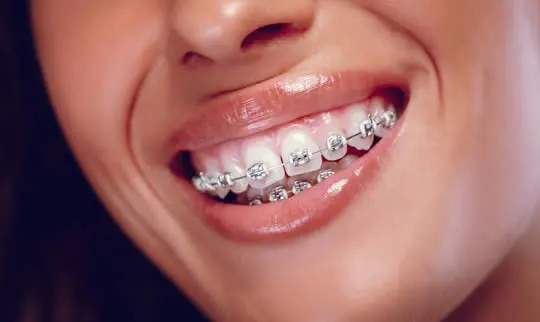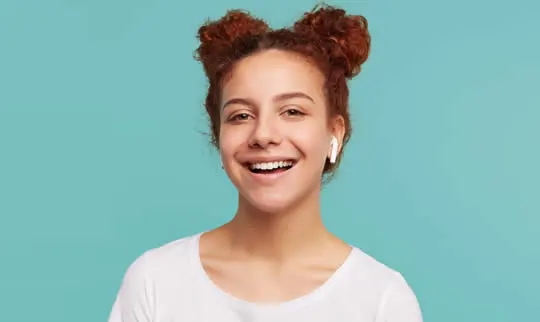Welcome to practiceName, located in Portland, where drName and our exceptional team are passionately committed to delivering the highest quality orthodontic care tailored to meet your unique needs and exceed your expectations. We firmly believe that you deserve the best, and we are here to provide it.
Whether you are contemplating orthodontic treatment for yourself or a loved one, we invite you to take the first step towards a beautiful, healthy smile by scheduling an examination with us. Our dedicated team will carefully evaluate your specific dental needs and discuss how orthodontics can bring numerous benefits to your life.

Why consider braces?
Don’t let the stereotypes surrounding orthodontic treatment hold you back. Braces have become more comfortable and discreet than ever, with a wide range of exciting options available to enhance your smile. There are numerous reasons why patients schedule consultations with drName to explore the potential benefits of braces. One common issue is malocclusion, which refers to a misalignment of teeth between the upper and lower arches. This condition is often known as an overbite or underbite. Here are the three categories to consider:
- Class I: An ideal relationship between your arches, with perfectly aligned molars, but with teeth crowding or spacing problems.
- Class II: The upper jaw extends too far forward, resulting in an overbite.
- Class III: The lower jaw extends too far forward, resulting in an underbite.
If you have crowded teeth, it means there isn’t enough space in your mouth to accommodate all of them, leading to overlapping, rotation, or incorrect positioning. On the other hand, spacing problems occur when there is excessive space in your mouth, which can be due to a large jaw or small teeth.
If you neglect to address these orthodontic problems by pursuing braces, you may experience the following conditions:
- Tooth decay and gum disease
- Difficulty chewing and eating
- Teeth grinding or clenching
- Speech impairments
- Sleep apnea and snoring
- Jaw pain or Temporomandibular Joint Disorder (TMJ)
What is early orthodontics?
According to the American Association of Orthodontists, it is recommended that children have their first orthodontic appointment by the age of 7. At this stage, teeth and jaws are still developing, and addressing certain conditions becomes easier before growth is complete. Early orthodontic intervention may involve guiding permanent teeth into better positions as they emerge, using a palatal expander to widen the palate for proper sizing of the upper arch, or recommending partial braces or space maintainers to prevent tooth crowding. In some cases, headgear may be beneficial to correct misaligned jaws. However, it’s important to note that not all young patients require intervention. drName will conduct diagnostic tests, including X-rays, to determine the ideal timing for treatment, which may be during the teenage years or not required at all.

What are traditional braces?
Traditional braces consist of metal brackets, bands, and wires securely attached to your teeth throughout the treatment process. These braces utilize small elastic bands to hold the wire in place, allowing gradual teeth movement as desired. Some patients, especially younger ones, enjoy adding a personal touch to their braces by choosing fun colors for the elastics, adding a touch of individuality to their smiles. Regular visits to practiceName every 4 to 6 weeks are necessary to adjust the wire and ensure progress continues. The duration of treatment varies but typically ranges from 1 to 3 years.
Traditional braces are particularly effective in addressing complex orthodontic issues that may not be as successfully treated with alternative methods. As these braces are securely cemented in your mouth, there is no risk of misplacing or not wearing them as required. It is common to experience some discomfort when the wire is tightened and your teeth adjust to new positions.
If traditional braces are recommended for you, please follow these guidelines:
- Adhere to drName’s list of foods to avoid while wearing braces. Chewy, hard, or sticky foods can damage your braces and contribute to tooth decay.
- Take extra care when performing oral hygiene tasks, including brushing and flossing. This may require some additional effort due to the presence of braces, but it is crucial for maintaining good oral health.
- Attend all scheduled appointments to stay on track with your treatment timeline and increase the likelihood of successful outcomes.
What are Damon braces?
Damon braces offer a fresh approach to traditional orthodontic treatment. They are classified as self-ligating braces, eliminating the need for elastic bands. Instead, a sliding mechanism secures the wire in place, allowing teeth to move freely and comfortably at their own pace. The Damon system utilizes highly advanced memory wires that facilitate faster tooth movement, resulting in fewer adjustments. With Damon braces, tooth alignment can often be achieved without the necessity for tooth extractions or the use of palatal expanders.
An alternative option known as Damon Clear braces is also available. These braces are nearly invisible in your smile and are resistant to discoloration or staining. Damon braces are designed to provide comfort and require less maintenance. Compared to traditional braces, they typically require approximately seven fewer office visits. Additionally, treatment time may be reduced by up to six months when utilizing Damon braces. Caring for Damon braces is straightforward and hassle-free.
What are clear aligners?
Clear aligners represent the pinnacle of discreet orthodontic treatment, particularly favored by adult patients. These aligners are constructed from clear plastic material and are custom-made to fit each patient precisely. Utilizing advanced imaging and impressions, clear aligners gradually guide teeth into improved positions with minimal discomfort and inconvenience compared to traditional braces.
Typically, aligners are worn for approximately two weeks before progressing to the next set in the series. The duration of the entire treatment process ranges from 6 to 18 months, depending on the individual’s specific conditions. Follow-up visits to practiceName are generally required every six weeks or as recommended by the orthodontist, and no uncomfortable adjustments are necessary.
One of the most appealing features of clear aligners is their removability, allowing easy removal for eating and oral hygiene. This means no dietary restrictions and the ability to maintain your regular dental care routine. For optimal results, it is advised to wear aligners for at least 22 hours a day. Additionally, a version of clear aligners designed specifically for teens is available, offering extra perks such as an indicator dot that alerts the teen when it is time to change to the next aligner.

What happens after braces?
After any kind of braces treatment, wearing a retainer is an important step in maintain the results of treatment. Otherwise, your teeth will slowly move out of place. Two common types of retainers are used by our dental office:
Removable – a customized acrylic mold is made from impressions of your mouth that fits into your palate. The acrylic piece attaches to hooks that go around the back of your teeth and there’s a wire across the front. On your lower arch, the acrylic portion is U-shaped due to your tongue. You should wear your retainers all the time for the first three months after braces, and then only at night if your teeth are not shifting. For ideal results, drName suggests you wear your retainers at night indefinitely.
Fixed – a thin wire is bonded in place across the back of your teeth. It is very strong and should be only removed by drName. These are not visible since they are behind your teeth, but can be hard to clean around. If a fixed retainer becomes loose, schedule an appointment for repair. Most patients are advised to keep their fixed retainers in place for life.
Periodic maintenance is necessary with both types of retainers. Regular dental checkups and cleanings help with hygiene to ensure the best oral health. With proper retainer wear, you can enjoy your new smile forever.
ADDITIONAL FREQUENTLY ASKED QUESTIONS ABOUT DENTAL BRACES
How long does orthodontic treatment typically last?
The duration of orthodontic treatment varies depending on individual factors. On average, treatment can range from 1 to 3 years, but it is best to consult with Dr. drName to get a more accurate estimate based on your specific orthodontic needs.
FAQ: Can I participate in sports or play musical instruments while wearing braces?
Answer: Absolutely! Wearing braces doesn’t have to hinder your active lifestyle or musical interests. While some adjustments may be needed, we can provide guidance and solutions to ensure you can continue participating in sports and playing musical instruments comfortably and safely.
FAQ: Are there any alternative treatment options to traditional braces?
Answer: Yes, there are alternative orthodontic treatment options available, such as clear aligners. Clear aligners are virtually invisible, removable, and offer a more discreet and convenient option for straightening teeth. Dr. drName can evaluate your specific case and recommend the best treatment option for you.
FAQ: How often should I schedule orthodontic check-ups during treatment?
Answer: Regular check-ups are essential for monitoring your progress and making necessary adjustments. Generally, orthodontic visits are scheduled every 4 to 6 weeks. However, Dr. drName will provide you with a personalized treatment plan that includes specific appointment intervals based on your individual needs.
FAQ: Will orthodontic treatment interfere with my daily oral hygiene routine?
Answer: Orthodontic treatment requires some adjustments to your oral hygiene routine, but it doesn’t have to be complicated. We will provide you with instructions on how to properly brush and floss with braces or aligners to maintain good oral health throughout your treatment journey.
FAQ: Can orthodontic treatment improve my bite and jaw alignment?
Answer: Yes, orthodontic treatment can help correct bite issues and improve jaw alignment. Conditions like overbite, underbite, crossbite, and open bite can often be addressed through orthodontic treatment, resulting in a more balanced and functional bite.
FAQ: What happens if I don’t wear my retainer after orthodontic treatment?
Answer: Wearing a retainer after orthodontic treatment is crucial to maintain the results achieved. If you neglect to wear your retainer as instructed, there is a risk of teeth shifting back to their original positions. Consistently wearing your retainer, as recommended by Dr. drName, will help ensure the longevity of your newly straightened smile.
Can I participate in sports or play musical instruments while wearing braces?
Absolutely! Wearing braces doesn’t have to hinder your active lifestyle or musical interests. While some adjustments may be needed, we can provide guidance and solutions to ensure you can continue participating in sports and playing musical instruments comfortably and safely.
Are there any alternative treatment options to traditional braces?
Yes, there are alternative orthodontic treatment options available, such as clear aligners. Clear aligners are virtually invisible, removable, and offer a more discreet and convenient option for straightening teeth. drName can evaluate your specific case and recommend the best treatment option for you.
How often should I schedule orthodontic check-ups during treatment?
Regular check-ups are essential for monitoring your progress and making necessary adjustments. Generally, orthodontic visits are scheduled every 4 to 6 weeks. However, Dr. drName will provide you with a personalized treatment plan that includes specific appointment intervals based on your individual needs.
Will orthodontic treatment interfere with my daily oral hygiene routine?
Orthodontic treatment requires some adjustments to your oral hygiene routine, but it doesn’t have to be complicated. We will provide you with instructions on how to properly brush and floss with braces or aligners to maintain good oral health throughout your treatment journey.
Can orthodontic treatment improve my bite and jaw alignment?
Yes, orthodontic treatment can help correct bite issues and improve jaw alignment. Conditions like overbite, underbite, crossbite, and open bite can often be addressed through orthodontic treatment, resulting in a more balanced and functional bite.
What happens if I don't wear my retainer after orthodontic treatment?
Wearing a retainer after orthodontic treatment is crucial to maintain the results achieved. If you neglect to wear your retainer as instructed, there is a risk of teeth shifting back to their original positions. Consistently wearing your retainer, as recommended by drName, will help ensure the longevity of your newly straightened smile.
Is there an orthodontist near me in Portland that offers orthodontic treatment?
Yes. At our Portland orthodontic office we offer orthontics to kids, teens, and adults. If you live in Portland or the surrounding area, contact our office today to schedule an appointment.
Helpful Related Links
- American Dental Association (ADA). Glossary of Dental Terms.
- WebMD. What is an orthodontist
